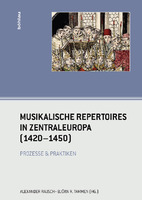Musikalische Repertoires in Zentraleuropa (1420-1450)
Prozesse & Praktiken
| dc.contributor.author | Tammen, Björn Renko | |
| dc.contributor.author | Rausch, Alexander | |
| dc.date.accessioned | 2014-12-31 23:55:55 | |
| dc.date.accessioned | 2020-01-30 13:03:30 | |
| dc.date.accessioned | 2020-04-01T14:38:47Z | |
| dc.date.available | 2020-04-01T14:38:47Z | |
| dc.date.issued | 2014 | |
| dc.identifier | 512255 | |
| dc.identifier | OCN: 960756863 | en_US |
| dc.identifier.uri | http://library.oapen.org/handle/20.500.12657/33287 | |
| dc.description.abstract | With famous music manuscripts such as the St Emmeram codex or the Trent codices and the rise of a musical elite with singer-composers around Dufay and Binchois, the years around 1430 belong to a crucial period in late-medieval music history. The present volume comprises 13 case studies on polyphonic as well as monophonic repertories with a particular focus on the city of Vienna. For the first time, the ‘simultaneity’ of ‘non-simultaneous’ phenomena is scrutinized for Central Europe and for the cultural exchange with neighbouring territories of the Holy Roman Empire, of England, Bohemia and Northern Italy.Due to its specific urban profile and the geographical position, late-medieval Vienna offers an excellent starting point for the study of musical repertories in Central Europe and their appropriation as cultural practice in the first half of the fifteenth century. The ‘simultaneity’ of ‘non-simultaneous’ phenomena is closely connected to the coexistence of different patterns of music patronage within court and nobility, the university, a variety of ecclesiastical institutions (among them the collegiate church of All Saints, later St Stephen’s Cathedral), and diverse strands of upper- and middle-class citizens on the one hand, cultural exchange with neighbouring territories of the Holy Roman Empire, of England, Bohemia and Northern Italy on the other. Manifold strands of polyphonic and monophonic repertories (both sacred and profane), compositional techniques, regionally bound stylistic peculiarities, strategems of music patronage, institutional (or even personal) collectionism, furthermore aspects of music iconography and the role of music within the history of ideas are scrutinized in thirteen chapters, which are conceived as case-studies, plus a detailed thematical introduction. In sum, this is an invaluable contribution to a better understanding of a crucial period of late-medieval music history. | |
| dc.language | English | |
| dc.language | German | |
| dc.subject.classification | thema EDItEUR::A The Arts::AV Music | en_US |
| dc.subject.other | Music history | |
| dc.subject.other | Late Middle Ages | |
| dc.subject.other | musical repertories | |
| dc.subject.other | music patronage | |
| dc.subject.other | ritual | |
| dc.subject.other | identity | |
| dc.subject.other | awareness of time | |
| dc.subject.other | Trent codices | |
| dc.subject.other | Hermann Poetzlinger | |
| dc.subject.other | mensural codex St. Emmeram | |
| dc.subject.other | England | |
| dc.subject.other | John Dunstaple | |
| dc.subject.other | Guillaume Dufay | |
| dc.subject.other | Gilles Binchois | |
| dc.subject.other | Central Europe | |
| dc.subject.other | Vienna | |
| dc.subject.other | Hermann Edlerawer | |
| dc.subject.other | Urbanus Kungsperger | |
| dc.subject.other | Johannes Brassart | |
| dc.subject.other | Johannes de Sarto | |
| dc.subject.other | Frederick III (IV) of Habsburg | |
| dc.subject.other | Albert II (V) of Habsburg | |
| dc.subject.other | Rudolf Volkhardt | |
| dc.subject.other | Petrus Wilhelmi de Grudencz | |
| dc.subject.other | Bohemia | |
| dc.subject.other | Veneto | |
| dc.subject.other | motet | |
| dc.subject.other | devotional motet | |
| dc.subject.other | genre transformation | |
| dc.subject.other | Marian devotions | |
| dc.subject.other | musical iconography | |
| dc.subject.other | chapel | |
| dc.subject.other | Sangvers | |
| dc.subject.other | Oswald von Wolkenstein | |
| dc.subject.other | Hugo von Montfort | |
| dc.subject.other | Michel Beheim | |
| dc.subject.other | Heinrich der Teichner | |
| dc.subject.other | Peter Suchenwirt | |
| dc.subject.other | Monk of Salzburg | |
| dc.subject.other | Liebhard Eghenvelder | |
| dc.subject.other | Neidhart (Nithart) | |
| dc.subject.other | Austrian National Library | |
| dc.subject.other | University of Vienna | |
| dc.subject.other | Council of Constance | |
| dc.subject.other | Council of Basle | |
| dc.subject.other | Nibelungenlied | |
| dc.subject.other | Johannes Lupi | |
| dc.subject.other | Johannes Wiser | |
| dc.subject.other | Johannes Prenner | |
| dc.subject.other | Regensburg | |
| dc.subject.other | St Stephen | |
| dc.subject.other | St Martin | |
| dc.subject.other | Jan Hus | |
| dc.subject.other | isorhythmic motet | |
| dc.subject.other | Ghent altarpiece | |
| dc.subject.other | Jan van Eyck | |
| dc.subject.other | Hubert van Eyck | |
| dc.subject.other | Musikgeschichte | |
| dc.subject.other | Polyphony | |
| dc.title | Musikalische Repertoires in Zentraleuropa (1420-1450) | |
| dc.title.alternative | Prozesse & Praktiken | |
| dc.type | book | |
| oapen.abstract.otherlanguage | Mit berühmten Repertoire-Handschriften wie dem Mensuralcodex St. Emmeram oder den Trienter Codices und der Entstehung einer musikalischen Elite um Sängerkomponisten wie Dufay und Binchois gehören die Jahrzehnte um 1430 zu einer Schlüsselphase der abendländischen Musikgeschichte. Der Band vereint 13 Fallstudien zur polyphonen Kunstmusik sowie zum einstimmigen Lied, wobei ein besonderer Fokus auf den Verhältnissen in Wien liegt. Erstmals wird so die Gleichzeitigkeit ungleichzeitiger Phänomene für Zentraleuropa beleuchtet – auch hinsichtlich der Wechselwirkungen mit England, Böhmen, Oberitalien und dem franko-flämischen Raum. | |
| oapen.identifier.doi | 10.26530/oapen_512255 | |
| oapen.relation.isPublishedBy | af16fd4b-42a1-46ed-82e8-c5e880252480 | * |
| oapen.relation.isFundedBy | 26ae1657-c58f-4f1d-a392-585ee75c293e | |
| oapen.relation.isbn | 9783205795629 | |
| oapen.collection | Austrian Science Fund (FWF) | |
| oapen.imprint | Böhlau | |
| oapen.pages | 422 | |
| oapen.grant.number | PUB 160 | |
| oapen.remark.public | Relevant Wikipedia pages: John Dunstaple - https://en.wikipedia.org/wiki/John_Dunstaple; Polyphony - https://en.wikipedia.org/wiki/Polyphony | |
| oapen.identifier.ocn | 960756863 |

